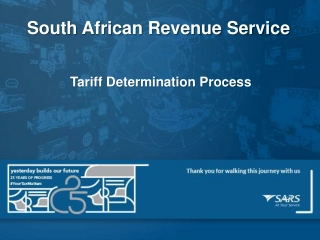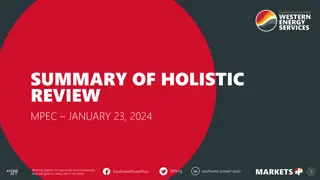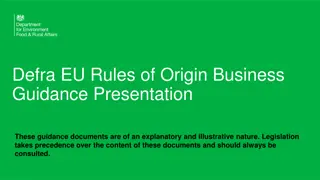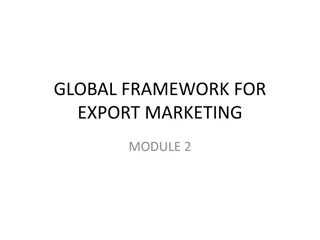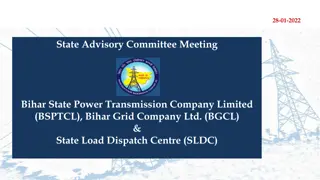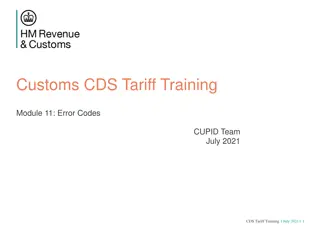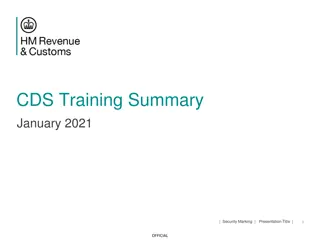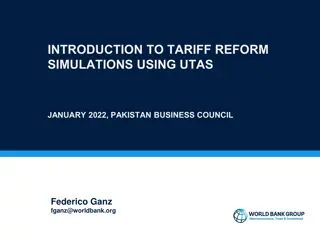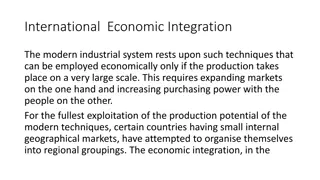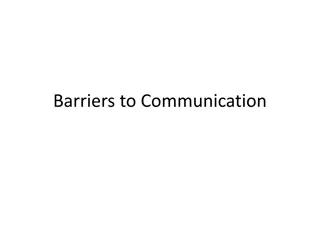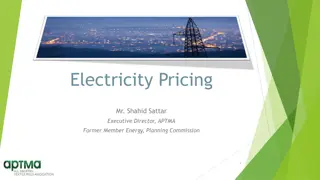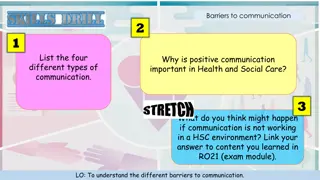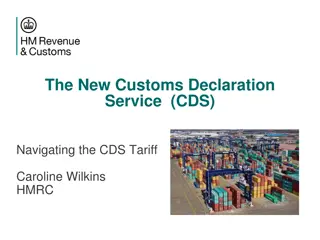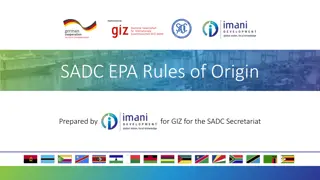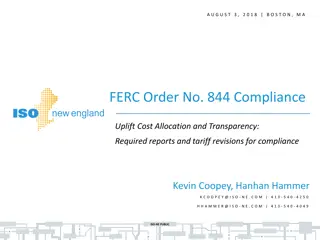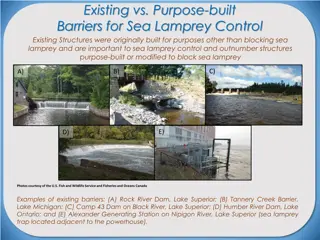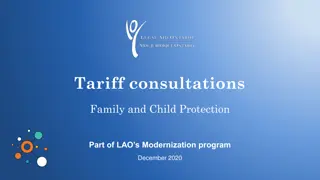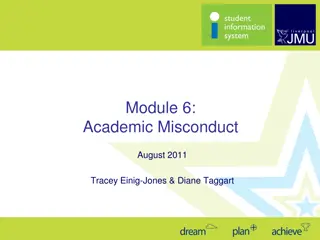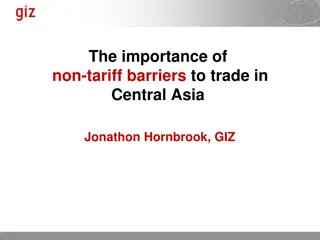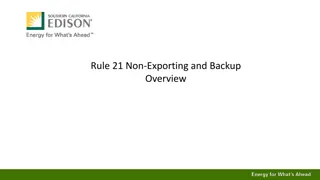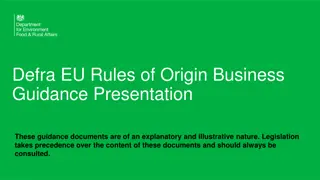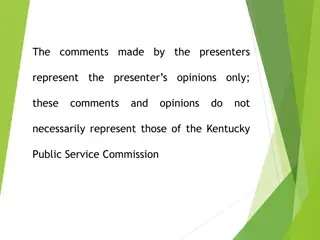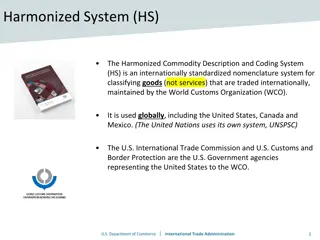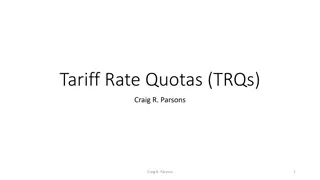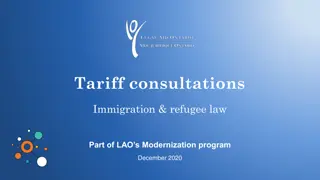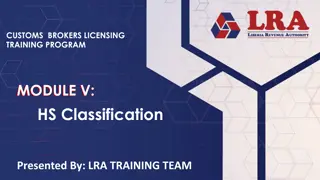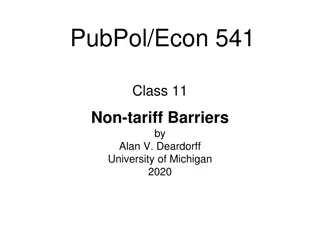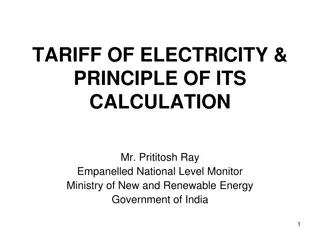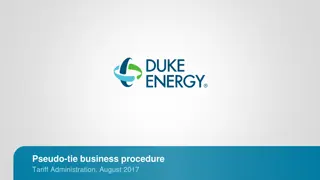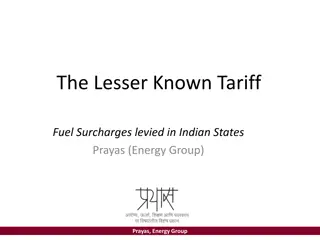Understanding SARS Tariff Determination Process
Explore SARS procedures for tariff determination and legislation provisions. Discover key discussions on customs, compliance, and international conventions.
1 views • 47 slides
Summary of Holistic Review of MPEC Tariff
Provide a summary of the holistic review conducted by SPP Staff on the MPEC Tariff, covering both non-substantive and substantive changes made for review and approval by MDWG. The review includes critical dates, tariff outline, updates from working groups/task forces, and a detailed table of content
0 views • 11 slides
Understanding Rules of Origin and Tariff-Free Trading with the EU
Rules of Origin (RoO) determine the economic nationality of a product, impacting tariffs and restrictions. To trade tariff-free with the EU, compliance with RoO is crucial. Specific rules dictate ingredient sourcing, with certification processes ensuring eligibility for tariff reductions. Certain pr
0 views • 19 slides
Understanding Trade Barriers and Tariff Classification
Explore the concept of trade barriers, including tariff and non-tariff barriers, their objectives, types, and classification. Learn about the benefits of tariff barriers, like discouraging imports and protecting home industries, and the classification of non-tariff barriers such as the quota system
3 views • 28 slides
Advisory Committee Meeting Summary for BSPTCL, BGCL & SLDC
The meeting discussed various topics including tariff petitions, business plans, network status, capacity additions, and cost optimizations for BSPTCL, BGCL, and SLDC in Bihar. Tariff projections, revenue requirements, transmission charges, and revenue surpluses were also analyzed and carried forwar
0 views • 23 slides
Understanding Error Codes in Customs CDS Tariff Training Module 11
This module focuses on interpreting error messages, identifying issues, and correcting errors in Customs CDS Tariff declarations. Learn about error code reference numbers, error descriptions, error locations, and how to fix common issues. Gain insights into cross-validation errors and protective mar
0 views • 13 slides
CDS Training Summary January 2021: Security Marking Presentation
In the CDS Training Summary for January 2021, the focus is on navigating the CDS Volume 3 Tariff, covering declaration categories, data elements, procedure codes, additional information codes, document codes, and more. The training provides a step-by-step guide on using the CDS Tariff, Volume 3, for
0 views • 69 slides
Understanding Tariff Reform Simulations Using UTAS
This presentation introduces tariff reform simulations using UTAS in the context of the car economy example. It covers how tariffs on imported goods impact production costs and effective protection of domestic industries. Key concepts such as output tariff, upstream tariff, and effective protection
0 views • 15 slides
Benefits of Economic Integration
Economic integration involves the unification of distinct economies into a larger economic region through the removal of trade barriers. It leads to economies of scale, international specialization, qualitative improvement in output, expansion of employment, and improvement in terms of trade. These
0 views • 33 slides
Understanding Entry and Exit Barriers in Industries
Entry and exit barriers play a significant role in shaping industry attractiveness and competitiveness. High entry barriers can deter new entrants, leading to stable returns but also higher risks. Conversely, low entry barriers may attract new players during economic upturns but result in intense ri
1 views • 15 slides
Understanding and Overcoming Communication Barriers
Communication barriers, such as physical, linguistic, cultural, mechanical, organizational, and psychological factors, can hinder effective message transmission and understanding. Physical barriers like noise and environmental stress, linguistic barriers including language ambiguity and jargon, cult
0 views • 11 slides
Understanding Electricity Pricing and Tariff Structure in Pakistan
Electricity pricing involves costs of power plant operations and grid maintenance, impacted by factors like fuel cost, regulations, and consumer demand. Pakistan's tariff structure uses an incremental block tariff system to manage usage, with mechanisms set by regulators for fair pricing and afforda
0 views • 16 slides
Understanding and Addressing Learning and Language Barriers in Children with Autism
Children with autism face various obstacles in language and social development. The VB-MAPP Barriers Assessment helps identify and score different barriers affecting individual children. Intervention strategies should directly target the sources of control for observed behaviors. Assessment and indi
1 views • 58 slides
Understanding Barriers to Communication in Health and Social Care
Communication barriers in Health and Social Care settings can hinder effective interactions. Positive communication is crucial in these environments to facilitate understanding and empathy. Recognizing and addressing barriers such as language differences, patronizing language, tiredness, inappropria
0 views • 31 slides
Comprehensive Guide to the New Customs Declaration Service (CDS)
Navigating the CDS Tariff, UCC alignment, strategic facilitations for UK business, and essential information on the Customs Declaration Service. Learn about data elements, tariff publications, and key changes under CDS for a comprehensive understanding of the trade environment.
0 views • 27 slides
Understanding Communication Barriers: Insights from Dr. Nadeem Khan
Communication barriers can hinder the effectiveness of communication processes. Psychological barriers, physiological barriers, physical barriers, and attitudinal barriers all play a role in how messages are received and understood. Recognizing and addressing these barriers is essential for improvin
0 views • 12 slides
International Market Entry Strategies Overview
As trade barriers diminish globally, companies must formulate effective strategies to enter international markets. The choice of foreign market entry strategy depends on risk levels, resource commitment, and return on investment. Various strategies such as export-import trade, turn-key projects, for
0 views • 23 slides
Technical Soundness of EU-SADC EPA Rules of Origin
The implementation and technical soundness of Rules of Origin under the EU-SADC EPA are crucial for the utilization of trade preferences. Compliance with rules of origin is essential for receiving tariff preferences, but drafting these rules accurately is challenging. Recommendations include specify
4 views • 12 slides
Understanding Tariff Systems in Mathematical Literacy - NQF Level 2
Exploring tariff systems in Mathematical Literacy at NQF Level 2, focusing on phone tariffs, calculations, and understanding bundled deals. Learn about different types of tariffs, their costs, and how to analyze and calculate monthly expenses for various phone plans.
0 views • 24 slides
FERC Order 844 Compliance: Uplift Cost Allocation and Transparency
FERC Order 844, issued in April 2018, mandates reporting on uplift payments and unit commitments, along with revising tariff language for compliance. ISO-NE is proposing new reports and tariff revisions to adhere to the Order, enhancing transparency in operational practices. The Order aims to improv
1 views • 30 slides
New UCAS Tariff for Higher Education Entry Overview
UCAS has introduced a new Tariff for higher education entry starting from September 2017. This toolkit is designed to assist teachers and advisers in understanding the changes, timeline, points system, university examples, myth debunking, and available resources. The aim is to prepare educators and
0 views • 32 slides
Existing vs. Purpose-built Barriers for Sea Lamprey Control
Existing structures originally built for other purposes play a crucial role in sea lamprey control, outnumbering purpose-built or modified barriers. Examples include dams and barriers in the Great Lakes region. This article discusses the importance, applications, limitations, and effectiveness of ex
0 views • 14 slides
Managing Fish Barriers in Scotland: Improving Water Environments
The management plans and implementation of fish barriers measures in Scotland aim to address key pressures on the water environment, such as fish migration, physical condition, and pollution. The initiative involves categorizing barriers, taking actions on fish migration, scoping barriers, assessing
0 views • 9 slides
Overview of LAO's Tariff Consultations for Family and Child Protection Modernization Program
LAO is seeking input on tariff reform as part of its modernization program to enhance Ontario's legal aid system. The focus is on immediate, cost-neutral updates and future potential increases. Feedback will help simplify billing rules, improve online services, and streamline access to information,
0 views • 15 slides
Understanding LJMU Penalty Tariff for Academic Misconduct
The LJMU Penalty Tariff, implemented from September 2011, ensures fair and consistent penalties for academic misconduct at LJMU. Points are allocated based on criteria, with penalties ranging from allowing new work submissions to expulsion. AMP outcomes are recorded using Service Indicators that rem
0 views • 17 slides
Challenges and Solutions in Trade Barriers in Central Asia
Understanding the significance of non-tariff barriers to trade in Central Asia, this presentation by Jonathon Hornbrook discusses the impact of Russia's WTO membership, WTO policies, and the challenges faced due to NTBs, EDB trade, TBTs, and NQI issues in the region. It highlights the importance of
1 views • 13 slides
Overview of Rule 21 Non-Exporting and Backup Options
This content provides an overview of Rule 21 Non-Exporting and Backup options. It covers non-exporting projects, backup systems, inadvertent exports, NEM solar with paired storage, and non-export options for storage under the Rule 21 tariff/option. Detailed information is presented regarding project
0 views • 8 slides
Preparing Energy Storage Systems for Public Safety Power Shutoff Events
Modernizing the NEM tariff to allow pre-PSPS charging involves utilities proposing modifications to allow energy storage systems to temporarily import energy from the grid upon advanced notification of a PSPS event. This process includes coordination with developers/aggregators and consultation with
0 views • 7 slides
Understanding Rules of Origin in EU-UK Trade
Rules of Origin (RoO) are essential in determining the economic nationality of products for tariff classification in EU-UK trade. Compliance with RoO is necessary for accessing preferential tariff rates under free trade agreements. This guidance outlines the principles, conditions, and requirements
0 views • 19 slides
Kentucky Public Service Commission Overview
Kentucky Public Service Commission (PSC) is responsible for regulating non-recurring charges, purchased water adjustments, and ensuring utilities adhere to tariff regulations. The PSC provides forms and guidelines for cost justifications and filings, along with information on utility regulations. Th
0 views • 40 slides
Understanding the Harmonized System (HS) for International Trade
The Harmonized System (HS) is an internationally standardized nomenclature system for classifying goods traded internationally, managed by the World Customs Organization (WCO). It organizes goods into categories down to the 6-digit level, providing a common set of descriptive categories for global t
0 views • 10 slides
Understanding Tariff Rate Quotas (TRQs) in International Trade
Tariff Rate Quotas (TRQs) are commonly used in global trade, particularly in agricultural imports. They involve lower tariff rates on imports up to a specified quantity per year, with higher rates applied to any excess imports. This system aims to regulate trade and protect domestic producers. TRQ l
0 views • 10 slides
Legal Aid Ontario's Tariff Consultations and Modernization Program
Legal Aid Ontario (LAO) is modernizing its legal aid system to better serve the community by seeking input on tariff reforms, improving access to information, and redesigning Legal Aid Online. Through cost-neutral updates, LAO aims to enhance efficiency and accountability while ensuring fair payment
0 views • 16 slides
Customs Brokers Licensing Training Program Module V: HS Classification Overview
Enhance your knowledge and skills in customs brokerage to pass the licensing uniform examination successfully. This module covers the evolution of customs nomenclature, reasons for tariff classification, HS structure, and more essential topics. Participants will learn to define technical terms, comp
0 views • 38 slides
Understanding Non-Tariff Barriers in International Trade
Explore the types of Non-Tariff Barriers (NTBs) and Non-Tariff Measures (NTMs) such as quotas, Tariff-Rate Quotas (TRQs), Voluntary Export Restraints (VERs), and more. Learn about Administered Protection, Safeguards tariffs, Anti-dumping duties, Countervailing duties, and their implications on trade
0 views • 57 slides
Understanding Tariff of Electricity and Principles of Calculation
Electrical energy production involves costs that are shared by consumers based on the amount and nature of electricity consumed. This includes fixed costs for setting up power plants and variable costs for generating electricity, which covers fuel expenses. The calculation of electricity costs is ba
0 views • 18 slides
Dafili Socio-Economic & Tariff Study Presentation Summary
Presentation delivered by Mike Wood at a CMP meeting in Dukem on June 19, 2013, focused on a socio-economic and tariff study for the Dafili community. The study aimed to gather demographic data, assess the community's ability and willingness to pay for water, recommend affordable tariffs, and evalua
0 views • 29 slides
Lubbock Retail Integration Task Force Updates and Resolutions
Lubbock Retail Integration Task Force (LRITF) discusses key implementation issues for LP&L entering competition, including Retail Access Tariff, CSA & Mass Transition Transaction Workflows, Customer Data, and Customer Choice Billing. Updates on resolving existing tariff restrictions and ERCOT functi
0 views • 10 slides
Pseudo-Tie Business Procedure Tariff Administration, August 2017
Pseudo-tie business procedure tariff administration from August 2017 outlines the purpose, implementation, and types of pseudo-ties in the energy industry. It covers dynamic transfers, pseudo-tie procedures, and various stakeholder involvements. The document details the process of implementing pseud
0 views • 11 slides
Analysis of Lesser Known Tariff Fuel Surcharges in Indian States by Prayas Energy Group
This report by Prayas Energy Group delves into the lesser-known tariff fuel surcharges levied in 15 Indian states, highlighting the processes, practices, and policy implications. Fuel surcharges are crucial for addressing power procurement cost deviations and play a significant role in DISCOM viabil
0 views • 26 slides
